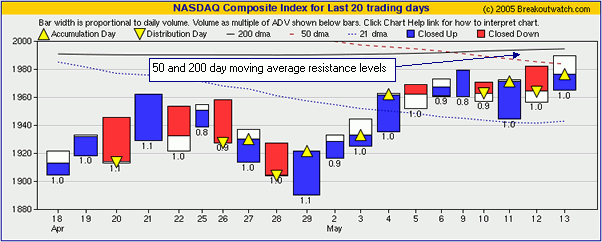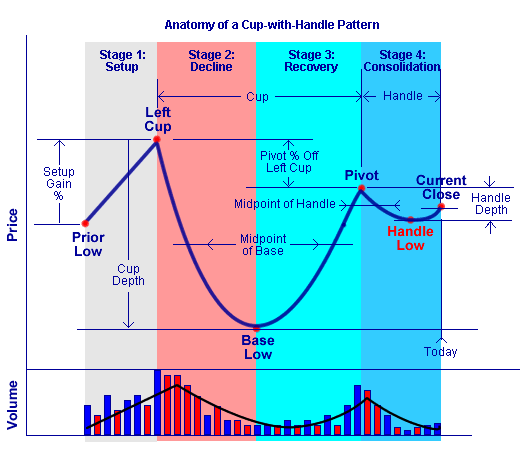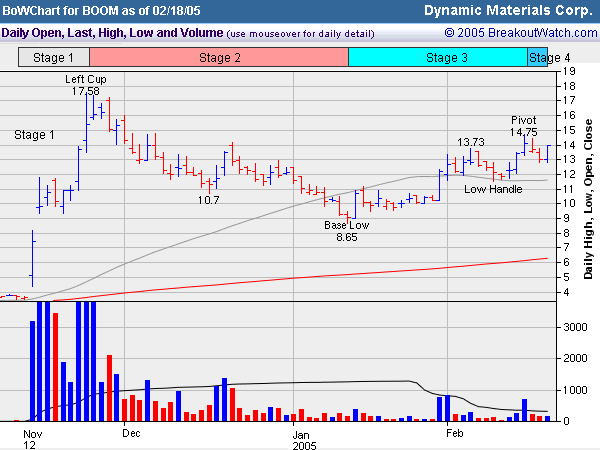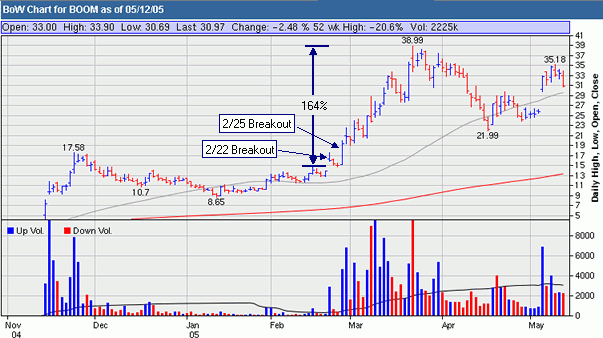| Market Summary | Weekly Breakout Report | Top Breakout Choices | Top 2nd Chances | New Features | Tip of the Week |
Market Summary
A divergence in market trends occurred this week as the DJI and S&P 500 confirmed the downtrend we anticipated last week and the NASDAQ continued to rally.
The DJI lost 1.98% for the week. After only briefly penetrating its 200 day moving average on Monday, it pulled back and then suffered three distribution days. Although these were not sufficient to change our market signal for the DJI, this index looks set to test support at the 10,000 level, effectively killing the rally that began on April 21.
The S&P 500 had been consolidating between its 50 and 200 day moving averages, but that came to an end on Friday as the index closed below the 200 day moving average level. For the week, the S&P 500 lost 1.48%. This index also looks as though it will test support at the April 20 low level of 1135.
The NASDAQ Composite continued the upward trend that was confirmed last week when our market signal changed for this index. Two accumulation days were matched by two distribution days and the index gained 0.48% for the week. The index is now butting up against two resistance levels in close proximity (see chart). On Friday it briefly crossed the 50 day moving average level before retreating to close below it, and just above the 50 is the 200. The index's ability to leap these two hurdles will be a test of strength in the coming week.

The NASDAQ is still the hardest hit index this year with a loss of 9.13% but is now the strongest performing index over 1, 13 and 26 weeks.
Breakouts
The number of successful breakouts fell by 30% this week with only 23 being confirmed. There were 6 that made intraday gains of more than 5%, but only one, NURO, that made double digit intraday gains. The average gains for the week were hurt by two breakouts, SYX and BEAV, that fell below the 8% stop loss limit. SYX broke out strongly on Tuesday only to suffer a reversal on Wednesday when it announced it would restate its results and closed down 26.3% from its breakout price. This confirms the importance of placing stop loss orders, even on new breakouts, if you are not able to constantly monitor the markets.
Breakdowns
There were just 4 confirmed breakdowns this week.
Industry Analysis
Oil and Gas Drilling dominated the industry rankings for the first 4 months of the year, but with oil prices slipping, they have now been replaced by Healthcare-Hospitals as the top performing industry, as measured on a technical ranking basis. On the site, you can analyze the best performing industries by technicals, fundamentals or price alone and see the top performers and under performers over several time frames.
Get a 14 day Trial of our premium 'Platinum' service for just $9.95 and if you subsequently subscribe to any subscription level we will credit your $9.95 to your subscription. 14
Day Platinum Trial |
There were no new features added this week.
Anatomy of a Cup-with-Handle Chart Pattern
This week we are going to analyze why a cup with handle forms, the desirable features of the pattern and how we select them. We will also look at an example of one of the best performing cup-with-handle formations this year.

Stage 1: Setup. The pattern starts with a stock rising from a former base. At some point, profit taking sets-in and the stock begins to decline, ending the setup. The maximum price reached at the end of Stage 1 is called the 'Left Cup', and the amount by which the stock rose from its prior low is the Setup Gain. To ensure a well-defined left cup, we require that the setup gain be at least 30% from the prior low level for it to qualify as a valid left cup.
Stage 2: Decline. The stock now collapses into a new base. The collapse can occur for any number of reasons: poor company results; over-all market conditions; bad news; profit taking after a strong setup stage, and so on. There should be strong selling and volume should be well above average for the first few days of the collapse. Note that collapsing price alone is not sufficient to provide a good CwH pattern, volume is also important. This is because we want most of the buyers from the setup stage to liquidate their holdings, so there will not be a lot of overhead supply when the stock begins to climb the right side of the cup. The combined price and volume action in stage 2 is important if the eventual breakout is to succeed. By the end of stage 2, volume should have fallen to well below average levels as most holders have sold and there is little buying activity, if any. The depth of the base is important also. We do not want the stock to collapse to a level from which recovery will be difficult, if not impossible, so when selecting CwH stocks for our watchlist we limit the cup depth to be at most 60% of the left cup price.
Stage 3: Recovery. If and when the conditions that brought about the stage 2 collapse have been resolved, the stock may begin to recover. If it does so, the stock will start to climb the right side of the cup. As it does so, we like to see above average volume on days when the price moves up, which indicates that institutions are taking an interest in the stock, but light volume on days when it closes down, indicating that there are small numbers of sellers. Ideally, this constructive price and volume action will strengthen as the right side of the cup is formed and the stock moves higher. Meanwhile, there will be some holders of the stock who bought at or near the left cup price but didn't sell in stage 2. These holders are waiting for the time when they can recoup some or all of their losses. There will also be profit taking by bottom-fishers. As losses are covered or profits are taken there will be pauses in the recovery and a typical cup right-side will exhibit a stair-step characteristic, rather than the smooth ascension shown in the idealized chart. Each of these pauses, or pullbacks, reduces the overhead supply left over from the left cup setup.
As the price on the right side approaches the left cup level, the last holders will finally decide to cut their losses and there will be a large volume sell-off. This often is preceded by a day on which the price spikes on high volume which the sellers have interpreted as an overbought condition and therefore a last opportunity to recoup their losses. This is the point at which the pivot forms, and marks the end of the recovery stage.
There are several technical conditions that must be met before our algorithm will recognize a valid pivot. Firstly we want the stock to have attained a strong relative strength when compared to all other stocks, so we require an RS of 70 on a scale from 1-99. We also want the pivot to be approaching the left cup level, so we require the pivot price to be at least 60% of the left cup. Thirdly, there must have been sufficient time for a shakeout of holders during stage 2, and sufficient time for institutions to notice and take an interest in the stock during stage 3. This is essential if the stock is to be projected to new highs after the breakout. Consequently, we require the distance from the left cup to the pivot, to be at least 6 weeks (30 sessions). On the other hand, we don't want the cup to be so long as to be meaningless, so there is a maximum cup length of 325 sessions imposed. A complete list of our criteria is provided at the end of this article.
We mentioned above the need for constructive price/volume action while the stock is building the right side of its cup. This is measured by our Right Cup Quality indicator (RCQ) and is a component of our overall Chart Quality metric (CQ). CQ is described here.
Stage 4: Consolidation. After the pivot we want and expect to see a shakeout while the overhead supply is depleted. This will cause the price to decline, initially on high volume but then the price should stabilize or drift down on volume well below average levels. The institutions who are tracking the stock know that they want the overhead supply eliminated and will wait for these stable conditions to materialize before they pounce. To identify well behaved handles, we require that the decline (or 'droop') in the handle should not be more than 30% of the pivot price, that the mid-point of the handle be above the mid-point of the base and that the minimum time spent in the handle should be two days, but that the overall handle length should not be more than 90 days. We also do not want the handle to be disproprtionate to the cup, so we require that the handle be no longer than a third of the cup length. The two day handle minimum is quite short but we want to make sure we don't miss any strong candidates (as will be seen shortly). We give our subscribers the ability to filter out short handles if they wish.
We measure the price/volume action in the handle using a proprietary metric called Handle Quality (HQ), which is also a component of CQ, mentioned earlier.
After the price has stabilized, it is not uncommon to see the price begin to rise on higher volume. This is an indication that institutions are starting to nibble and may indicate a strong breakout to come. We have noticed that breakouts are 17% stronger, on average, when the price and volume rise on the day before the breakout. See our newsletter of 4/23/05.
When the conditions described in these 4 stages are satisfied, we have a valid CwH pattern and the stock will be placed on our CwH watchlist, CwHWatch. If the conditions change so the stock no longer meets the criteria, then the stock will be dropped from CwHWatch. We monitor the stock while it is on CwH Watch and issue a real-time alert if the pivot price is met or exceeded and the projected daily volume exceeded 1.5 times the average daily volume - an indication that institutions are buying the stock in large quantities.
A CwH Example: Boom
On November 12, 2004, Dynamic Materials reported earnings of 16 cents a share compared to a loss of 13 cents a share for the same quarter a year earlier, and predicted strong future earnings based on order backlogs (see story). The stock went from $3.66 to $17.58 (a 380% gain) in the next 8 sessions, completing its stage 1 setup. The stock then entered the stage 2 decline as profit taking took over and after one failed recovery attempt the stock lost almost 50% of its value. At its low, volume was well below the average and had almost returned to the pre-November12 levels. The recovery then began with constructive price/volume action as needed. As price and volume picked up, the stock formed a low handle with pivot at 13.73. The mid-point of this handle was below the mid-point of the base, however, so it did not qualify for our CwHWatch. A valid pivot did form on Feb. 15 at 14.75 with positive HQ and RCQ values and our Expected Gain model predicted a gain of 66% if the stock broke out. On February 18 the stock indicated it was ready to move higher when it closed at its high of the day. After the long weekend it gapped up at the open by more than $2 and broke out on nearly 8 times average daily volume. It formed a second short handle and broke out again on 2/25 on 10 times average daily volume and went on to gain 164% in the next month.
Cup-with-Handle Chart for BOOM as of 02/18/05

Cup-with Handle Chart for BOOM as of 5/12/05 showing progress since breakout.

|
Item
|
Definition
|
CwHWatch Criteria
|
|---|---|---|
Current Close |
The price at which the stock closed on the
day it is included in CwHwatch. This is updated each day that the stock
remains on the list. |
>= $6 |
Average Volume |
The average daily volume over the last 50
days |
>=30,000 |
|
RSRank |
The stock’s weighted price appreciation over the prior year, as ranked against all other stocks in our database. |
>=70 |
Setup Gain |
The amount by which the stock price rose
from its prior low to the left cup, measured as a percentage of the previous
low. |
>=30% |
|
Cup |
Trading days between Left Cup and Current Close. |
>=30 days |
|
Handle |
Action on the right side of the Cup in which the price has discontinued rising, falling back slightly in a tight consolidation. (see Pivot) |
>= 2 days and <= 90 days * |
Cup:Handle Ratio |
The length of the cup
relative to the length of the handle. |
>= 3 |
|
Handle Low |
Lowest intraday low within the Handle. |
>= 99% of 200 day moving average |
|
Pivot |
Highest intraday high that marks the beginning of the Handle. |
Must exist |
|
Handle Depth |
Difference between the Pivot and the Handle Low, expressed as a percentage of the Pivot. |
<= 30% |
|
Pivot % off Left Cup |
Difference between the Left Cup and the Pivot, expressed as a percentage of the Left Cup. |
<= +5% and >= -40% |
|
Midpoint of Base |
Price which marks half the distance between the Left Cup and the Base Low. |
None |
|
Midpoint of Handle |
Price which marks half the distance between the Pivot and the Handle Low. |
>= Midpoint of Base |
Get a 14 day Trial of our premium 'Platinum' service for just $9.95 and if you subsequently subscribe to any subscription level we will credit your $9.95 to your subscription. 14
Day Platinum Trial |
| Index | Value | Change Week | Change YTD | Market1 Signal |
||||||||||||||||||||||||||||||||||||
|---|---|---|---|---|---|---|---|---|---|---|---|---|---|---|---|---|---|---|---|---|---|---|---|---|---|---|---|---|---|---|---|---|---|---|---|---|---|---|---|---|
| Dow | 10140.1 | -1.98% | -5.96% | enter | ||||||||||||||||||||||||||||||||||||
| NASDAQ | 1976.8 | 0.48% | -9.13% | enter | ||||||||||||||||||||||||||||||||||||
| S&P 500 | 1154.05 | -1.48% | -4.78% | enter | ||||||||||||||||||||||||||||||||||||
1The Market Signal is derived from our proprietary
market model. The market model is described on the site. 2The site also shows industry rankings based on fundamentals, combined technical and fundamentals, and on price alone (similar to IBD). The site also shows daily industry movements. |
||||||||||||||||||||||||||||||||||||||||
# of Breakouts
|
Period Average1
|
Max. Gain During Period2
|
Gain at Period Close3
|
|
|---|---|---|---|---|
| This Week | 23 | 22.54 | 3.84% | -1.5% |
| Last Week | 35 | 23.15 | 7.74% | 1.46% |
| 13 Weeks | 344 | 24.85 | 9.97% |
-3.2% |
Sector
|
Industry
|
Breakout Count for Week
|
|---|---|---|
Computer Software
|
Comp Software-Enterprise
|
2
|
Healthcare
|
Healthcare-Products
|
2
|
Aerospace & Defense
|
Aerospace & Defense-Equip
|
1
|
Business Services
|
Business Svcs-Sec/Safety
|
1
|
Business Services
|
Business Svcs-Leasing
|
1
|
Business Services
|
Business Svcs-Misc
|
1
|
Computer
|
Computer-Services
|
1
|
Computer
|
Computer-Graphics
|
1
|
Electronics
|
Electr-Semicndtr Mfg
|
1
|
Electronics
|
Electr-Semicndtr Equip
|
1
|
Healthcare
|
Healthcare-Med/Dent Services
|
1
|
Healthcare
|
Healthcare-Biomed/Genetic
|
1
|
Healthcare
|
Healthcare-Hospitals
|
1
|
Media
|
Media-Newspapers
|
1
|
Oil & Gas
|
Oil & Gas-U S Explr/Prod
|
1
|
Paper
|
Paper
|
1
|
Real Estate/ REIT
|
Real Estate-REIT
|
1
|
Retail
|
Retail-Computers/Mobile
|
1
|
Steel
|
Steel -Specialty
|
1
|
2This represents the return if each stock were bought at its breakout price and sold at its intraday high.
3This represents the return if each stock were bought at its breakout price and sold at the most recent close.
Category |
Symbol |
Company Name |
Expected Gain1 |
|---|---|---|---|
| Best Overall | ABIX | ABATIX CORP | 94 |
| Top Technical | VDSI | VASCO DATA SEC INTL INC | 57 |
| Top Fundamental | RRGB | RED ROBIN GOURMET BURGERS IN | 20 |
| Top Tech. & Fund. | RRGB | RED ROBIN GOURMET BURGERS IN | 20 |
Category |
Symbol |
Company Name |
Expected Gain1 |
|---|---|---|---|
| Best Overall | NSDA | NASSDA CORP | 127 |
| Top Technical | NSDA | NASSDA CORP | 127 |
| Top Fundamental | SFY | SWIFT ENERGY CO | 16 |
| Top Tech. & Fund. | SFY | SWIFT ENERGY CO | 16 |
If you received this newletter from a friend and you would like to receive it regularly please go to the BreakoutWatch.com site and enter as a Guest. You will then be able to register to receive the newsletter.
Copyright © 2005 NBIcharts, LLC dba BreakoutWatch.com. All rights reserved.